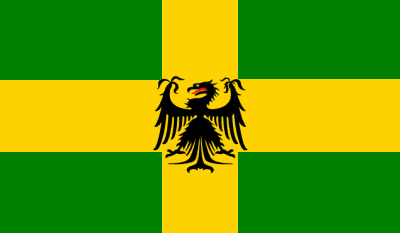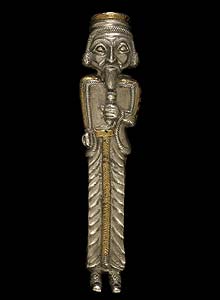Jugenskaja

|
[[Image:{{{coat of arms}}}|100px]] |
| Feudal Status: | County |
| Capital: | Jugensk |
| Largest Cities: | Jugensk |
|
| |
| Local Leadership Title: | The Count |
| Local Government: | Laschist Autocracy (Laqi Populist) |
| Current leader: | Nickolas Turner |
|
| |
| Local language: | English, Laqi |
| Local Religion: | Cedrism,Orthodox & Jewish minorities |
WARNING. PAGE IS UNDER CONSTRUCTION.
Contents
History & Culture
The County of Jugenskaja is a relatively new county, previously known as Shimmerspring. A central county within the Barony of K'Tzuni, it is land locked and is currently maintained by Count Nickolas Turner.
Thousands of years ago (around 12 ASC), a nomadic tribe resided here called the Juuk's, which roughly translates into southern peoples in their native language. The tribe itself was nomadic, but found the rich farmland of this land to be superior to that of the surrounding land. For the next thousand years, mingling with neighboring tribes and civilizations the modern people of Jugenskaja came about.
The Juuks became known for their fine metal work, as natural deposits of chromium were found throughout the land. Lavish statues, jewelry and other trinkets made the Juuks a center of great wealth and trade. Northern tribes traded their gold for the Juuks artistry, thus allowing them to incorporate gold into their works, as seen below.
The small statuette of a Juuk chieftain above is made of pure chromium with gold accents, and probably one of the most valuable items found in recent excavations; dated around 49 ASC.
By the mid 70's a trade route was established with people from the northern Benacia region, bringing hearty grains to the Juuks. This in turn gave the Juuks a reputation for distilling fine spirits of exceptional strength.
The 90's ASC
As the Juuks grew in numbers they spread throughout most of what is now Jugenskaja, some of the surrounding counties such as eastern Highpass, southern and central Caverden and small portions of northern most Lywind. In times before Shireroth, the Juuk Empire was feared by most neighboring tribes for their feirce warriors and rather modern siege machines.
Early 100's-200's
In 102 ASC, Central tribes began rising in power, and over took the Juuks when they tried to conquer what is now Woodshire. While the Juuks suffered a great defeat at the hands of the central tribes, this gave birth to a federation of tribes.
As always, the Juuks came to dominate, holding the most authority in the elder councils. Essentially they believed they alone possessed the divine right to rule through their holiest of Gods H'Graa. They eventually dominated the lands once again, and much of what is now modern Brookshire.
History
Before 4700 ASC
Around 4000 ASC, the Duchy of Machinara arose from the chaos of the House System, and covered the traditional territories of Brookshire, Goldshire, and Yardistan. The economic engine of the new Duchy were the Meshed Lands, an area centered in Caverden in which organic life was supplemented or supplanted by machines; technology ruled, and was exemplified by the cyborgs and other hybrid creatures that roamed the area. The Meshed Lands expanded slowly, converting areas on its borders into more of itself, but even those parts of Machinaria outside its direct influence felt its impact.
Shimmerspring was among its beneficiaries. The Meshed Lands abutted its borders, and although the Jugenskij were wary of the often-frightening transhumans that came down from the mountains, they were much more welcoming of the useful devices and technological wonders that accompanied them. Those that they could acquire were in high demand, and few locals could afford them due to the expense; nonetheless, they remained valuable as trade goods with the wealthier lands south and west, and the county's cities, particularly Jakovita, quietly profited.
Nevertheless, the period of decay that began inflicting Shireroth after the first quarter of the millennium did not spare Machinaria. For reasons still unclear to those outside, the Meshed Lands began to recede, and news and products from within likewise slowed to a trickle. Political authority, which had never been very centralized in the duchy, gently evaporated, and the far reaches of the duchy began slipping into chaos and economic decline. The year 4300 saw the secession of the Saran Confederacy, which effectively claimed all of Yardistan; in 4303, much of what is now northern Goldshire likewise seceded after a famine to form Raynoria. In the following decades, most of the rest of Machinaria likewise declined, and Shimmerspring was no exception. With their most profitable trade dried up, and their irreplaceable Meshed-produced devices failing one by one, the local urban economies began to collapse, and the population dispersed to the countryside.
The response of the Imperial Government was slow in coming, but in 4333 Kaiser Gaelen IV, realizing that order needed to be restored, decreed that Machinaria would be demoted to a Barony (consisting of Woodshire, Caverden, Monty Crisco, and Kralizec). He further recognized the Saran Confederacy and Raynoria as duchies, and divided the remainder of Machinaria between the two as spheres of influence. Though the maps specifying this arrangement are lost, the geography of the new polities imply that Shimmerspring fell within the Saran sphere.
Nonetheless, the reorganization of the subdivisions only slowed their decline, rather than stopping it. Machinaria as a small barony proved little more cohesive than as it had as an immense duchy, and its lands became little more than the increasingly reclusive Meshed Lands lumped together with a patchwork of small fiefdoms, all legally bound by Imperial fiat. The two new duchies fared rather better for a time, but even in the bustle of their youth paid little attention to their spheres of influence. Over the next century, Shimmerspring's urban life crumbled. The cities became lawless, underpopulated jungles of brick and concrete, and the hinterlands returned to farming and hunting for subsistence.
If they had been in a state to notice, the people of Shimmerspring might have taken solace in the fact that they were not alone. Civilization continued to unravel, until even the two local duchies themselves were not safe. Although Raynoria and the Saran Confederacy remained legally in existence, they had ceased to function by 4450, and fifty years after that were being referred to in the past tense. Southern Benacia had become a vast sea of subsistence lapping against the walls of Shirekeep. The Imperial Government, struggling to maintain Shireroth's far flung territories, debated for decades an effective way to revitalize the area.
It was not until the accession of Loki II in 4548 that events began to take a hopeful turn. The Kaiser and Adelsraad pushed for a restructuring of the Benacian territories, and threw their support behind the few remaining organs of government left behind from the Saran period to rebuild the ancient Duchy of Yardistan. In 4558, the Adelsraad reestablished Brookshire, placing it under Yardistani administration until local government could be sufficiently developed; indeed, the seeds of reborn authority had already been planted.
The inheritance of the manor of Maltenstein in Woodshire by Anthrazita Leichwittchen von Rossheim-Maltenstein was the springboard for her accession as Countess of Caverden in 4565; the county, till then a patchwork of transhumant communities, isolated pockets of Meshed Lands remnants, and human cities, was soon converted to a Lichgraviate by necromantic ritual. In 4567, the reformed Nation of Lakhesis was recognized by the Kaiser. Between them, the two entities became the dominant local powers in Brookshire, and their efforts at rebuilding the duchy led Loki IV to rescind Yardistani administration in 4571 and place it under his own protection in anticipation of its full autonomy, which finally occurred in 4574.
As infrastructure began to be rebuilt from Caverden and Lakhesis outwards, Shimmerspring continued to languish. Though directly between both counties, the difficulties of the terrain led the local powers to concentrate their mutual links through Highpass and Amarr. Through the 4580s, as Lakhesis expanded into a Barony and Caverden into a LIchgraviate of Overdolor, the progress of new roads into Shimmerspring was slow, and served mostly to allow easy exit from the sad villages of the Listva Valley to lands of greater opportunity.
The situation remained largely unchanged until the reign of Ayreon II and crises of the late 4600s. In 4674, the Barony of Greater Lakhesis was granted independence as the Free State of Sanilla without the say of Anthrazita, by this time Duchess of Brookshire. Outraged by the partition of her territory, she took the unprecedented step in 4679 of declaring Brookshire a kingdom within Shireroth. Seeking to assert greater control of those territories not already controlled by loyal vassals, she transformed a number of counties, including Shimmerspring, into provinces, and appointed a provincial governor for each.
Although Shimmerspring was a politically and economically unimportant territory, and subsequently ignored by the new Queen, the creation of a local administration provided a certain amount of benefit. The population decline was slowed and stopped, though it failed to rise significantly for many years. The cities, particularly Jugensk, were pacified and the empty sections demolished and (if possible) rebuilt or repurposed. The land was, if not improved, then at least tamed. Nonetheless, as the Queen rearranged and recombined provinces and counties to suit her whim, change, for good or ill, largely continued to pass Shimmerspring by.
4700 - 4800 ASC
Religious Aspects
For many years, the Juuks devoted themselves to H'Graa. The Order of H'Graa was a priesthood respected by all Juuks, as it is believed all priests of the order were tied to H'Graa in someway. The Lord of Wrath, head of the order, was said to have direct communication with H'Graa.
